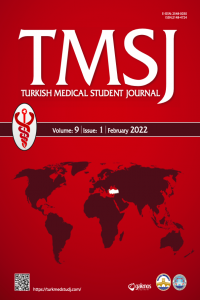EVALUATION OF TOILET HABITS AND SELF-AWARENESS OF CONSTIPATION STATUSES AMONG YOUNG ADULTS FROM DIFFERENT FACULTIES AT ACIBADEM UNIVERSITY
EVALUATION OF TOILET HABITS AND SELF-AWARENESS OF CONSTIPATION STATUSES AMONG YOUNG ADULTS FROM DIFFERENT FACULTIES AT ACIBADEM UNIVERSITY
Constipation, toilets habits, lifestyle, smartphone, young adult,
___
- 1. Chatoor D, Emmnauel A. Constipation and evacuation disorders. Best Pract Res Clin Gastroenterol 2009;23(4):517–30.
- 2. Kasap E, Bor S. Fonksiyonel barsak hastalığı prevalansı. Güncel Gastroenteroloji 2006;10(2):165-8.
- 3. Mugie SM, Benninga MA, Di Lorenzo C. Epidemiology of constipation in children and adults: A systematic review. Best Pract Res Clin Gastroenterol 2011;25(1):3-18.
- 4. Chu H, Zhong L, Li H et al. Epidemiology characteristics of constipation for gen- eral population, pediatric population, and elderly population in China. Gastroen- terol Res Pract 2014;2014:532734.
- 5. Bharucha AE, Pemberton JH, Locke GR 3rd. American Gastroenterological As- sociation technical review on constipation. Gastroenterology 2013;144(1):218-38.
- 6. Werth BL, Williams KA, Fisher MJ et al. Defining constipation to estimate its prevalence in the community: Results from a national survey. BMC Gastroenterol 2019;19(1):75.
- 7. Talley NJ, Weaver AL, Zinsmeister AR et al. Functional constipation and outlet delay: A population-based study. Gastroenterology 1993;105(3):781-90.
- 8. Schmulson MJ, Drossman DA. What is new in Rome IV. J Neurogastroenterol Motil 2017;23(2):151-63.
- 9. Simren M, Palsson OS, Whitehead WE. Update on Rome IV criteria for col- orectal disorders: Implications for clinical practice. Curr Gastroenterol Rep 2017;19(4):15.
- 10. Russo M, Strisciuglio C, Scarpato E et al. Functional chronic constipation: Rome III criteria versus Rome IV criteria. J Neurogastroenterol Motil 2019;25(1):123-8.
- 11. Lewis SJ, Heaton KW. Stool form scale as a useful guide to intestinal transit time. Scand J Gastroenterol 1977;32(9):920-4.
- 12. Markland AD, Palsson O, Goode PS et al. Association of low dietary intake of fiber and liquids with constipation: Evidence from the National Health and Nutri- tion Examination Survey. Am J Gastroenterol 2013;108(5):796-803.
- 13. Dukas L, Wilett WC, Giovannucci EL et al. Association between physical activity, fiber intake, and other lifestyle variables and constipation in a study of women. Am J Gastroeneterol 2003;98(8):1790-6.
- 14. Jangid V, Godhia M, Sanwalka N et al. Water intake, dietary fibre, defecatory hab- its and its association with chronic functional constipation. Curr Res Nutr Food Sci 2016;4(2):90-5.
- 15. Arnaud MJ. Mild dehydration: A risk factor of constipation? Eur J Clin Nutr 2003;57(2):88-95.
- 16. Dehn TC, Kettlewell MG. Haemorrhoids and defaecatory habits. Lancet 1989;1(8628):54-5.
- 17. Goldstein O, Shaham Y, Naftali T et al. Toilet reading habits in Israeli adults. Neu- rogastroenterol Motil 2009;21(3):291-5.
- 18. Berney CR. Smartphone lavatory syndrome. ANZ J Surg 2020;90(6):953-4.
- 19. Çelik S. The Relationship between hemorrhoids and smartphone use lavatory. Study record. Department of General Surgery, Yüzüncü Yıl University Faculty of Medicine: 2018 Feb. Report No: NCT03444389. Available from: URL: https:// clinicaltrials.gov/ct2/show/NCT03444389.
- 20. Duboc H, Coffin B, Siproudhis L. Disruption of circadian rhythms and gut mo- tility: An overview of underlying mechanisms and associated pathologies. J Clin Gastroenterol 2020;54(5):405-14.
- 21. Bavarsad MB, Azimi N, Moradbeigi K et al. Associations between morning- ness-eveningness and sleep quality among female dormitory residents. Thrita 2015;4(1):25088.
- 22. Andone, I, Błaszkiewicz K, Eibes M et al. How age and gender affect smartphone usage. Proceedings of the 2016 ACM International Joint Conference on Pervasive and Ubiquitous Computing Adjunct - UbiComp ’16; 2016, New York, NY, USA; 2016.p.9-12.
- ISSN: 2148-4724
- Başlangıç: 2014
- Yayıncı: Trakya Üniversitesi
Mustafa Ömer İZZETTİNOĞLU, Rüveyde GARİP
Fatih Erkan AKAY, Beliz KOÇYİĞİT, Fevzi Oktay ŞİŞMAN, Mert Yücel AYRIK, İpek SAVAŞIR, Elif CENGİZ, Ufuk DEMİRCİ, Hakkı Onur KIRKIZLAR
BODY DYSMORPHIC DISORDER: A COMPREHENSIVE REVIEW
Farheen MALİK, Jawad AHMED, Sundus NASİM, Aiman ALİ, Ahmad Rehan KHAN
SQUAMOUS CELL CARCINOMA OF THE CAUDAL NASAL SEPTUM AND THE NASAL VESTIBULE: A CASE REPORT
Berfin TAN, Elif CENGİZ, Berra KURTOĞLU, Elif ÇALIŞKAN, Kemal KEF
Muhammad Romail MANAN, Hamna MANAN
CASE REPORT OF AN INCIDENTAL UNICENTRIC CASTLEMAN DISEASE
Elif CENGİZ, Alperen Taha CERTEL, Mert Yücel AYRIK, Mehmet Gürkan ARIKAN, Elif MERCAN, Fulya ÖZ PUYAN, İrfan Hüseyin ATAKAN
INCIDENTAL DETECTION OF PREVIOUSLY UNKNOWN BREAST CANCER ON Tc-99m MIBI SCINTIGRAPHY
Nur Gülce İŞKAN, Şeyma Gizem ORUN, Ezgi GÖKDEMİR, Gülay Durmuş ALTUN
Nisanur KAYGISIZ, Atahan DURBAŞ, Hüseyin KARAMAN, Çağla Hamide SOLMAN, Özdal ERSOY
FEAR OF COVID-19 AMONG MEDICAL STUDENTS AND ASSOCIATED FACTORS
Berfin TAN, Beril AY, Janset ÖZDEMİR, Okan ÇALIYURT
MANAGEMENT OF A T-TUBE MIGRATION INTO THE SYRINX CAVITY: A CASE REPORT
Ceren YILMAZ, Erkan SEBİCİ, Mert Yücel AYRIK, Ahmet Hamit ÇINKI, Ahmet Tolgay AKINCI
